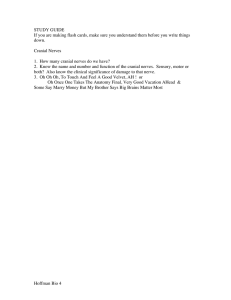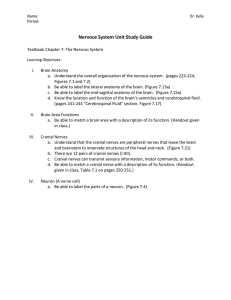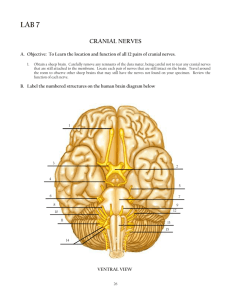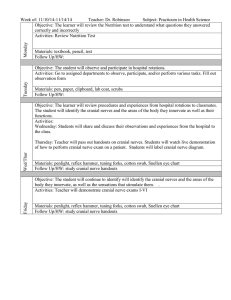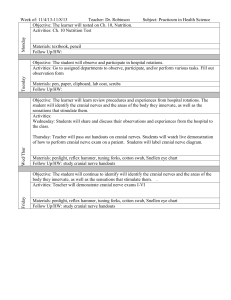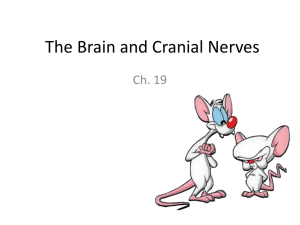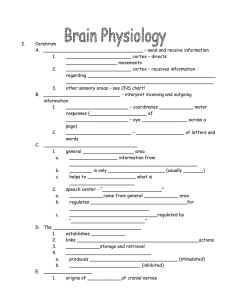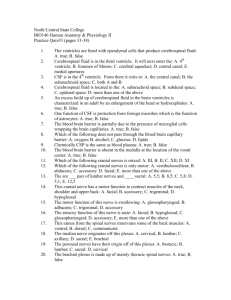Biology 241 – Lab LAB #17 17
advertisement
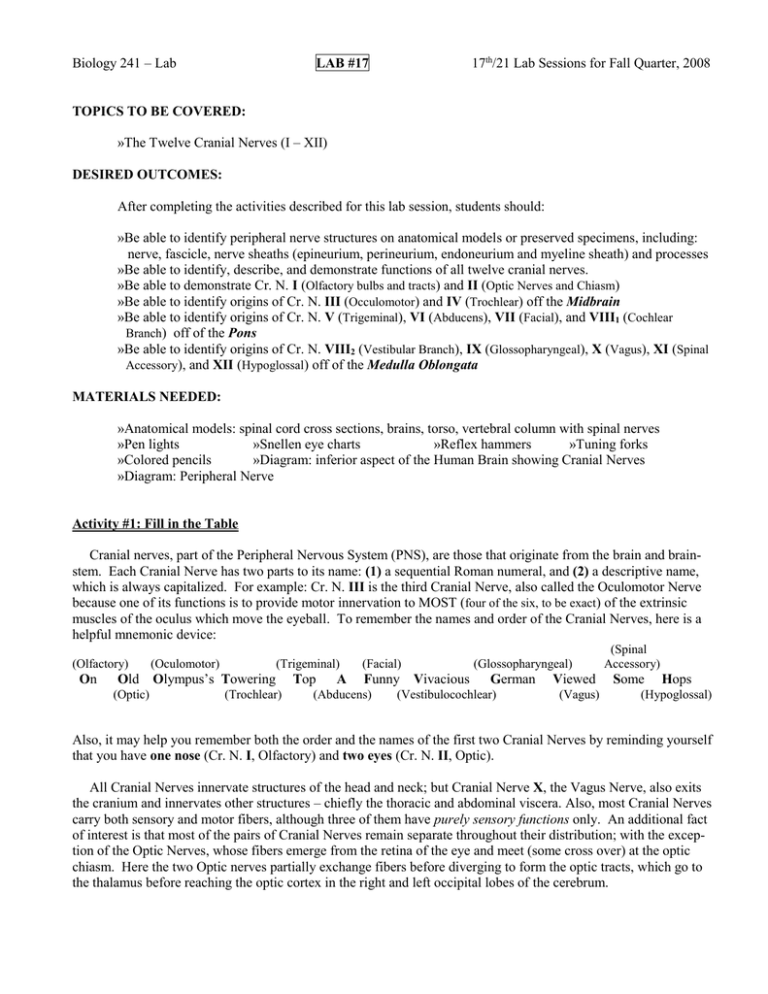
Biology 241 – Lab 17th/21 Lab Sessions for Fall Quarter, 2008 LAB #17 TOPICS TO BE COVERED: »The Twelve Cranial Nerves (I – XII) DESIRED OUTCOMES: After completing the activities described for this lab session, students should: »Be able to identify peripheral nerve structures on anatomical models or preserved specimens, including: nerve, fascicle, nerve sheaths (epineurium, perineurium, endoneurium and myeline sheath) and processes »Be able to identify, describe, and demonstrate functions of all twelve cranial nerves. »Be able to demonstrate Cr. N. I (Olfactory bulbs and tracts) and II (Optic Nerves and Chiasm) »Be able to identify origins of Cr. N. III (Occulomotor) and IV (Trochlear) off the Midbrain »Be able to identify origins of Cr. N. V (Trigeminal), VI (Abducens), VII (Facial), and VIII1 (Cochlear Branch) off of the Pons »Be able to identify origins of Cr. N. VIII2 (Vestibular Branch), IX (Glossopharyngeal), X (Vagus), XI (Spinal Accessory), and XII (Hypoglossal) off of the Medulla Oblongata MATERIALS NEEDED: »Anatomical models: spinal cord cross sections, brains, torso, vertebral column with spinal nerves »Pen lights »Snellen eye charts »Reflex hammers »Tuning forks »Colored pencils »Diagram: inferior aspect of the Human Brain showing Cranial Nerves »Diagram: Peripheral Nerve Activity #1: Fill in the Table Cranial nerves, part of the Peripheral Nervous System (PNS), are those that originate from the brain and brainstem. Each Cranial Nerve has two parts to its name: (1) a sequential Roman numeral, and (2) a descriptive name, which is always capitalized. For example: Cr. N. III is the third Cranial Nerve, also called the Oculomotor Nerve because one of its functions is to provide motor innervation to MOST (four of the six, to be exact) of the extrinsic muscles of the oculus which move the eyeball. To remember the names and order of the Cranial Nerves, here is a helpful mnemonic device: (Olfactory) On (Oculomotor) (Trigeminal) Old Olympus’s Towering (Optic) (Trochlear) Top A (Facial) Funny Vivacious (Abducens) (Glossopharyngeal) German (Vestibulocochlear) Viewed (Vagus) (Spinal Accessory) Some Hops (Hypoglossal) Also, it may help you remember both the order and the names of the first two Cranial Nerves by reminding yourself that you have one nose (Cr. N. I, Olfactory) and two eyes (Cr. N. II, Optic). All Cranial Nerves innervate structures of the head and neck; but Cranial Nerve X, the Vagus Nerve, also exits the cranium and innervates other structures – chiefly the thoracic and abdominal viscera. Also, most Cranial Nerves carry both sensory and motor fibers, although three of them have purely sensory functions only. An additional fact of interest is that most of the pairs of Cranial Nerves remain separate throughout their distribution; with the exception of the Optic Nerves, whose fibers emerge from the retina of the eye and meet (some cross over) at the optic chiasm. Here the two Optic nerves partially exchange fibers before diverging to form the optic tracts, which go to the thalamus before reaching the optic cortex in the right and left occipital lobes of the cerebrum. Biology 241 – Lab #17 – continued Page Two Fill in the following chart with information regarding the twelve pairs of Cranial Nerves appropriate to their: functions; location (meaning from which structure the nerve originates); and whether the nerve is motor, sensory, or both. (Please note that no nerve is purely motor, as all motor nerves carry proprioceptive sensory fibers from the muscles they innervate); but not counting this small component of sensory, you may consider the Cranial Nerve “purely motor”.)
